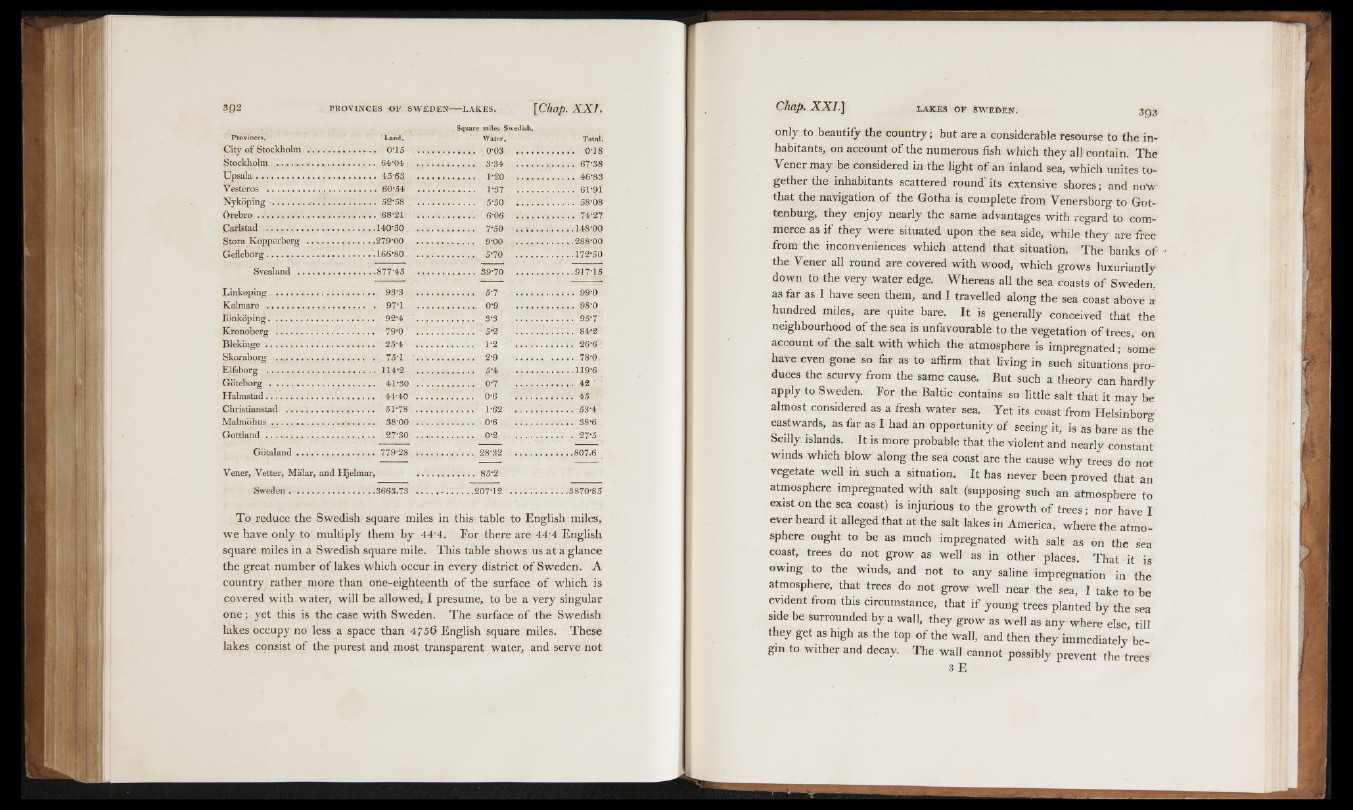
. . . . , .S q u are miles Swedish.
Provinces. Land. ' Water-. Total.
City of Stockholm . . . . . . . . . . . . . . 0*15 0*03 0*18
Stockholm ............ 64*04- . . . . . . . . . . . . 3-34 . . . . . . . . . . . . 67*88
Upsala 45*63 1*20 . 46*83
Vesteros 60*54 1*87 61*91
Nykoping .............................. ¡ . 52*58 . . . . ................. 5*50 58*08
Grebro 68*21 . . . . . I 6*06 74*27
Carlstad 140*50 7*50 . . ; 148*00
Stora Kopperberg .279*00 9*00 288*00
Gefleborg . 166*80 5*70 172*50
Svealand ......8 7 7 * 4 5 . . .39*70 917*15
Linköping .........93*3 .......... 5*7- - ......... 99*0
Kalmare .................................. . 97*1 ........................ 0*9 .................. ...... 98*0
Iönköping................ 92*4 .............. 3*3 95*7
Kronoberg . . . . . . . . . . . . . . . . . - . 79*0 5*2 ....................... 84*2 *
Blekinge.......................... .." 25*4..... ....................... 1*2 . . ’..-...* 7 ;.^ . 26*6 '
Skoraborg . 75*1 * ................. 2*9 . . . . . . . . . . . 7 8 * 0
Elifeborg ........................................... 114* ............. .. 5*4 . . . . . . . . ___ 1.19*6
Göteborg . . . . . . . . . . . . . . . . . . . . . 41*30 ........ .... . 0*7..............................42
Halmstad........................................... 44*40 ....................... 0*6 . . . . . . . . . . . . 45 -
Christians tad ................................... 51*78 ....................... 1*62 . . . . . . . . . . . . . 53*4’
Malmöhus........................................ 38*00 ............. 0*6 . .*........... 38*6
Go ttlan d............................................ 27*30 ............ 0*2............. 27*5
Götaland......................... 779*28 . . . . . . . . 28*32...................... 1 .807.6
Vener, Vetter, Malar, and Hjelmar, . . . . . . ’.......... 85*2
Sweden...................................3663.73 207*12 ....3870*85
To reduce the Swedish square miles in this table to English miles,
we have only to multiply them by 44*4. For there are 44*4 English
square miles in a Swedish square mile. This table shows us at a glance
the great number o f lakes which occur in every district of Sweden. A
country rather more than one-eighteenth o f the surface o f which is
covered with water, will be allowed, I presume, to be a very singular
one; yet this is the case with Sweden. The surface of the Swedish
lakes occupy no less a space than 4756 English square miles. These
lakes consist of the purest and most transparent water, and serve not
only to beautify the country; but are a considerable resourse to the inhabitants,
on account o f the numerous fish which they all contain. The
Vener may be considered in the light of an inland sea, which unites together
the inhabitants scattered round- its extensive shores; and now
that the navigation o f the Gotha is complete from Venersborg to Got-
tenburg, they enjoy nearly the same advantages with regard to commerce
as if they were situated upon the sea side, while they are free
from the inconveniences which attend that situation. The banks o f
the Vener all round are covered with wood, which grows luxuriantly
down to the very water edge. Whereas all the sea coasts o f Sweden,
as far as I have seen them, and I travelled along the sea coast above a
hundred miles, are quite bare. It is generally conceived that the
neighbourhood o f the sea is unfavourable to the vegetation o f trees, on
account o f the salt with which the atmosphere is impregnated; some
have even gone so far as to affirm that living in such situations produces
the scurvy from the same cause. But such a theory can hardly
apply to Sweden. For the Baltic contains so little salt that it may be
almost considered as a fresh water sea. Yet its coast from Helsinborg
eastwards, as far as I had an opportunity o f seeing it, is as bare as the
Scilly islands. It is more probable that the violent and nearly constant
winds which blow along the sea coast are the cause why trees do not
vegetate well in such a situation. It has never been proved that an
atmosphere impregnated with salt (supposing such an atmosphere to
exist on the sea coast) is injurious to the growth o f trees; nor have I
ever heard it alleged that at the salt lakes in America, where the atmosphere
ought to be as much impregnated with salt as on the sea
coast, trees do not grow as well as in other places. That it is
owing to the winds, and not to any saline impregnation in the
atmosphere, that trees do not grow well near the sea, I take to be
evident from this circumstance, that i f young trees planted by the sea
side be surrounded by a wall, they grow as well as any where else till
they get as high as the top o f the wall, and then they immediately begin
to wither and decay. The wall cannot possibly prevent the trees
3 E